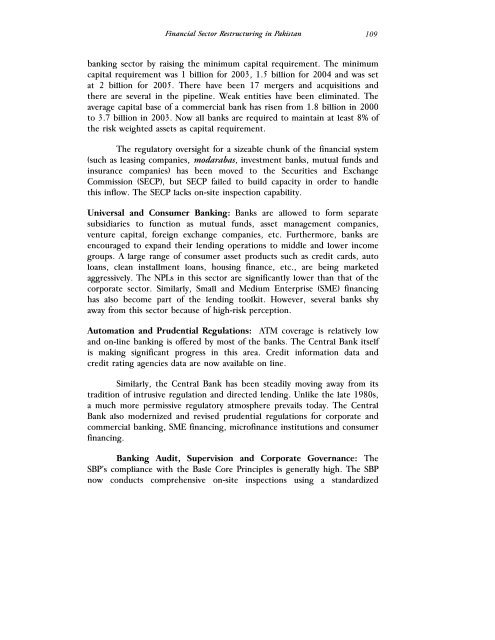Special Edition-07.pdf - Lahore School of Economics
Special Edition-07.pdf - Lahore School of Economics
Special Edition-07.pdf - Lahore School of Economics
You also want an ePaper? Increase the reach of your titles
YUMPU automatically turns print PDFs into web optimized ePapers that Google loves.
Financial Sector Restructuring in Pakistan 109<br />
banking sector by raising the minimum capital requirement. The minimum<br />
capital requirement was 1 billion for 2003, 1.5 billion for 2004 and was set<br />
at 2 billion for 2005. There have been 17 mergers and acquisitions and<br />
there are several in the pipeline. Weak entities have been eliminated. The<br />
average capital base <strong>of</strong> a commercial bank has risen from 1.8 billion in 2000<br />
to 3.7 billion in 2003. Now all banks are required to maintain at least 8% <strong>of</strong><br />
the risk weighted assets as capital requirement.<br />
The regulatory oversight for a sizeable chunk <strong>of</strong> the financial system<br />
(such as leasing companies, modarabas, investment banks, mutual funds and<br />
insurance companies) has been moved to the Securities and Exchange<br />
Commission (SECP), but SECP failed to build capacity in order to handle<br />
this inflow. The SECP lacks on-site inspection capability.<br />
Universal and Consumer Banking: Banks are allowed to form separate<br />
subsidiaries to function as mutual funds, asset management companies,<br />
venture capital, foreign exchange companies, etc. Furthermore, banks are<br />
encouraged to expand their lending operations to middle and lower income<br />
groups. A large range <strong>of</strong> consumer asset products such as credit cards, auto<br />
loans, clean installment loans, housing finance, etc., are being marketed<br />
aggressively. The NPLs in this sector are significantly lower than that <strong>of</strong> the<br />
corporate sector. Similarly, Small and Medium Enterprise (SME) financing<br />
has also become part <strong>of</strong> the lending toolkit. However, several banks shy<br />
away from this sector because <strong>of</strong> high-risk perception.<br />
Automation and Prudential Regulations: ATM coverage is relatively low<br />
and on-line banking is <strong>of</strong>fered by most <strong>of</strong> the banks. The Central Bank itself<br />
is making significant progress in this area. Credit information data and<br />
credit rating agencies data are now available on line.<br />
Similarly, the Central Bank has been steadily moving away from its<br />
tradition <strong>of</strong> intrusive regulation and directed lending. Unlike the late 1980s,<br />
a much more permissive regulatory atmosphere prevails today. The Central<br />
Bank also modernized and revised prudential regulations for corporate and<br />
commercial banking, SME financing, micr<strong>of</strong>inance institutions and consumer<br />
financing.<br />
Banking Audit, Supervision and Corporate Governance: The<br />
SBP’s compliance with the Basle Core Principles is generally high. The SBP<br />
now conducts comprehensive on-site inspections using a standardized

















